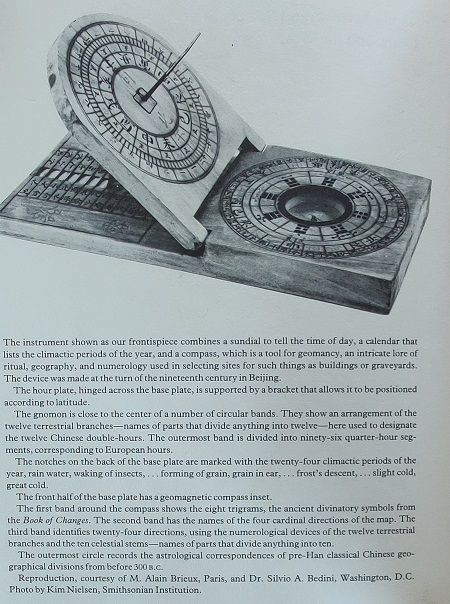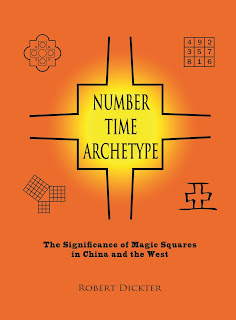Symbolic images and numerology belong to the very essence of the alchemists’
mentality. The use of symbols and numbers convey a much deeper communication,
or language, and therefore, have a much more profound affect on the
subconscious than the mere words of philosophy or mythology. The most profound symbols are archetypes,
symbols that live as ideas in our subconscious but link us to a collective society, as if archetypes are an intellectual vestige of an earlier civilization.
Magic
squares play a vital role in alchemy and magic.
Magic squares have a long history as talismans that date back 2,000
years. Magic squares possessed magical qualities that could ward off bad
spirits or bring good luck. Magic squares in the Luo Shu format form a “set” of
magic squares that are closely related to the Pythagorean Theorem (see last
post).
| 3x3 | 5x5 | 7x7 | ||||||||||||||
| Magic Square | Magic Square | Magic Square | ||||||||||||||
| 22 | 47 | 16 | 41 | 10 | 35 | 4 | ||||||||||
| 11 | 24 | 7 | 20 | 3 | 5 | 23 | 48 | 17 | 42 | 11 | 29 | |||||
| 4 | 9 | 2 | 4 | 12 | 25 | 8 | 16 | 30 | 6 | 24 | 48 | 18 | 36 | 12 | ||
| 3 | 5 | 7 | 17 | 5 | 13 | 21 | 9 | 13 | 31 | 7 | 25 | 43 | 19 | 37 | ||
| 8 | 1 | 6 | 10 | 18 | 1 | 14 | 22 | 38 | 14 | 32 | 1 | 26 | 44 | 20 | ||
| 23 | 6 | 19 | 2 | 15 | 21 | 39 | 8 | 33 | 2 | 27 | 45 | |||||
| 46 | 15 | 40 | 9 | 34 | 3 | 28 | ||||||||||
| SATURN | MARS | VENUS | ||||||||||||||
| LEAD | IRON | COPPER | ||||||||||||||
| EARTH | FIRE | METAL | ||||||||||||||
| BLACK | RED | GREEN | ||||||||||||||
| ONYX | RUBY | EMERLAD | ||||||||||||||
| CROCO | HORSE | DOVE | ||||||||||||||
Table One: The first three magic squares in the Luo Shu format with each demonstrating a unique Pythagorean triplet of numbers. Each magic square has an alchemical correspondence with a specific planet, metal, element, color, stone, and animal.
Magic Squares and the Kabbala
We are all
familiar with how the vast majority of people, for thousands of years as well
as presently, believe in the influences of the planets on the character of
humankind. The early Chinese, the Kabbalists, the shamans and magis all
developed systems to obtain the most auspicious of these influences that the
planets may impart.
The
Kabbalists assigned names and symbols to each planet. These signs were followed by magic
squares. The signs and magic squares for
the planets have been published in several books, one of the first by Cornelius
Agrippa, who completed De occulta
philosophia in 1510. The set of magic
squares also appeared in books by Luca Pacioli, De viribus quantitates (1498), and Athanasius Kircher, Arithmologia (1655). Magic squares were popular during the Italian
Renaissance and were known to the famous artists, mathematicians, and astronomers
of the time.
Magic Squares and Symbols
Time and
space have always been important concepts to philosophers, mathematicians, and
scientists. The carpenter’s square and
the magic square are ideal symbols for time and space with the history being
Chinese in origin.
A prosperous, evolving civilization
begins with the gnomon, an astronomical instrument which served as the keeper
of time for thousands of years. The
light of the sun would cause a shadow from the gnomon to appear on the ground
and measuring this shadow would determine the time of year.
It was because of the gnomon and the ordering of sequential time that allows for the necessity of Numbers and the preservation of the “Numbers of Time.”
Understandably, this took years of observing and record keeping but this was the method to determine summer and winter solstice.
It was because of the gnomon and the ordering of sequential time that allows for the necessity of Numbers and the preservation of the “Numbers of Time.”
Understandably, this took years of observing and record keeping but this was the method to determine summer and winter solstice.
The definition of gnomon, in Webster’s Dictionary, indicates that the word is inherently related to the carpenter’s square. In Joseph Needham’s Science and Civilisation in China (page i of any volume), the words carpenter’s square and gnomon are used interchangeably:
The carpenter’s square is no ordinary tool, but the gnomon for measuring the lengths of the
sun’s solstitial shadows.
Therefore,
the carpenter’s square measures time via the role of the gnomon and measures
space via it’s graduated numbers of measurement in combination with the right-angle
triangle theorem (the Pythagorean Theorem).
The gnomon, the most important astronomical instrument known to civilization for thousands of years.
The Chinese Connection to the Carpenter’s Square
A very old
Chinese pictogram, 工 (gong), refers to an artisan who carries
his carpenter’s square; the glyph is used in many words and also has a
relationship with music and astronomy. Another
very old pictogram, 曲 (chu,
ju, or jue) also means carpenter’s square.
One can see that, according to Mathew’s Chinese – English Dictionary
(1956), the glyph is related to many words, but like 工 (gong), is also
related to music. Alfred Schinz, in his
book The Magic Square (1996), reports
that the pictogram 曲 is
based on the 3x3 grid of the magic square and appeared on oracle bones dating
to the Shang dynasty (1100 BC).
If we
re-examine table one above, we can observe Pythagorean triplets of numbers in
the shape of a right angle or gnomon residing at the heart of each magic square. A gnomon shape of Pythagorean numbers in a
3x3 grid can explain why a pictogram such as 曲 (chu) means carpenter’s square.
Another interesting link exists with the English definition of gnomon with that of the Chinese. Referring to Webster’s Dictionary once again, the fourth definition of gnomon is canon or tenet.
This relates to the Chinese phrase 規矩 (gui chu) which combines the pictograms for the compass and carpenter’s square and means: following the rule of tradition and moral standards for establishing order; the way things should be. Measuring the shadow of the gnomon involved following the rules of tradition thereby creating a moral standard. Therefore, the ancient method to establish order involved using mathematical tools and traditional ways of observing and documenting the numbers of the shadow length. Thus, the English definition of gnomon referring to canon or tenet, that is, the way things should be may lead one to believe that the etymology of the Greek derived word gnomon may have a Chinese connection.
The importance of the gnomon to
civilization was documented by the early Chinese in one of the oldest math
books known, the Zhou bi suan jing, The Arithmetical Classic of the Gnomon and
the Circular Paths of Heaven, wherein it states, “the combination of the
right angle with numbers (the carpenter's square/gnomon) is what guides and rules the universe.”
These Chinese pictograms from thousands of years ago represent one
of the earliest written languages known to linguists. The use of mathematical symbols with the
incorporation of traditions were the basis of some important words (pictograms)
in the Chinese language and demonstrates the heavenly role the magic square
played in early Chinese civilization.
Diagrams such as the Chinese magic square contain vestiges of knowledge
of the most ancient human beings, reveal a mystical mathematical vision, and
may even be a link to a primitive, universal language.
Numbers, the right-angle triangle
theorem, the carpenter’s square, and the gnomon are inter-related with the
magic square, alchemy and magic; all of which make correspondences to math,
time, and space. Symbols and archetypes
are a natural result from the traditional and repetitive use of these functional
tools that help advance the prospects of human evolution and prosperity.
Mosaics from Ravenna, Italy represent some of the finest examples of early Christian art from the fifth to tenth century. It may be a far-fetched theory, but the symbols on the religious garments simulate the carpenter’s square and the Chinese 工 (gong) pictogram. Art historians have no explanation for these markings. However, it is known that in the middle ages, the Christian hierarchy was obsessed with obelisks, gnomons, astronomy instruments, Pythagorean symbolism, numerology, and magic squares, in other words, instruments of time and space. Was there a Chinese influence on early Christian art and architecture?
This blog is dedicated to mathematics and the magic square – to
learn more about how the magic square influenced Chinese civilization as well
as early Christian art and architecture, please order my book, Number Time Archetype.
·



















